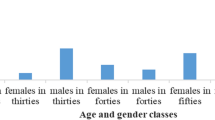Abstract
The aim of this paper is to describe the development of a speaker-independent continuous automatic Amazigh speech recognition system. The designed system is based on the Carnegie Mellon University Sphinx tools. In the training and testing phase an in house Amazigh_Alphadigits corpus was used. This corpus was collected in the framework of this work and consists of speech and their transcription of 60 Berber Moroccan speakers (30 males and 30 females) native of Tarifit Berber. The system obtained best performance of 92.89 % when trained using 16 Gaussian Mixture models.



Similar content being viewed by others
Notes
The Amazigh Speech Corpus was collected by students during two periods of three month: (Mars to Mai 2011 and 2012), within the framework of the graduate programs of the faculty Polydisciplinary of Nador, Morocco.
References
Abushariah, M. A. A. M., Ainon, R. N., Zainuddin, R., Elshafei, M., & Khalifa, O. O. (2012). Arabic speaker-independent continuous automatic speech recognition based on a phonetically rich and balanced speech corpus. International Arab Journal of Information Technology, 9(1), 84–93.
Ajami Alotaibi, Y. (2005). Investigating spoken Arabic digits in speech recognition setting. Information and Computer Science, 173, 115–139.
Alotaibi, Y. A., & Shahshavari, M. M. (1998). Speech recognition—What it takes for a computer to understand your commands. IEEE Potentials.
Al-Zabibi, M. (1990) An acoustic-phonetic approach in automatic Arabic Speech Recognition. The British Library in Association with UMI.
Amazigh Languages. (2013). Encyclopædia Britannica Online. Retrieved 23 June, 2013, from http://www.britannica.com/EBchecked/topic/61496/Amazigh-languages.
Boukous, A. (1995). Société, langues et cultures au Maroc: Enjeux symboliques (No. 8). Faculté des Lettres et des Sciences Humaines.
Boukous, A. (2009). Phonologie de l’amazighe. Rabat: Institut royal de la culture amazighe.
Chaker, S. (1984). Textes en linguistique berbère: introduction au domaine berbère. Paris: Ed. du C.N.R.S.
CMU lmtool. (2013). Retrieved June 23, 2013, from http://www.speech.cs.cmu.edu/tools/lmtool-new.html.
CMU Sphinx Open Source Speech Recognition Engines. (2013). Retrieved February 10, 2013, from http://www.cmusphinx.sourceforge.net/html/cmusphinx.php.
Cole, R., Fanty, M., Muthusamy, Y., & Gopalakrishnan, M. (1990). Speaker-independent recognition of spoken English letters. In International joint conference on neural networks (IJCNN) (Vol. 2, pp. 45–51).
Fadoua, A. A., & Siham, B. (2012). Natural language processing for Amazigh language: Challenges and future directions. Language Technology for Normalisation of Less-Resourced Languages, 19.
Galand, L. (1988). Le berbère. In J. Perrot (Ed.), Les langues dans le monde ancien et moderne. Part 3: Les langues chamito-sémitiques (pp. 207–242). Paris: CNRS.
Greenberg, J. H. (1966). The languages of Africa. Mouton: The Hague.
Haton, M.-C., Cerisara, C., Fohr, D., & Laprie, Y., & Smaili, K. (2006). Reconnaissance automatique de la parole du signal a son interpretation. Paris: Universciens Dunod.
Huang, X., Acero, A., & Hon, H. (2001). Spoken language processing a guide to theory, algorithm and system design. Upper Saddle River: Prentice Hall.
Huang, X. D. (1989). The SPHINX-II Speech Recognition System: An overview. Computer Speech and Language, 7(2), 137–148.
Huang, X. D., Ariki, Y., & Jack, M. A. (1990). Hidden Markov models for speech recognition. Edinburgh: Edinburgh University Press.
Hyassat, H., & Zitar, R. A. (2006). Arabic speech recognition using SPHINX engine. International Journal of Speech Technology, 9(3–4), 133–150.
Le, V. B., & Besacier, L. (2009). Automatic speech recognition for under-resourced languages: Application to Vietnamese language. IEEE Transactions on Audio, Speech, and Language Processing, 17(8), 1471–1482.
Lee, K. F. (1989). Automatic Speech Recognition the development of the SPHINX system. Boston: Kluwer.
Ouakrim, O. (1995). Fonética y fonología del Bereber. Survey: University of Autònoma de Barcelona.
Outahajala, M., Zenkouar, L., & Rosso, P. (2011). Building an annotated corpus for Amazighe. In Proceedings of 4th international conference on Amazigh and ICT, Rabat, Morocco.
Ridouane, R. (2003). Suites de consonnes en berbère: phonétique et phonologie. Doctoral Dissertation, Université de la Sorbonne nouvelle-Paris III.
Satori, H., Harti, M., & Chenfour, N. (2007). Arabic Speech Recognition system based on CMUSphinx. In Proceedings of ISCIII2007, 3rd international symposium on computational intelligence and intelligent informatics, Agadir, Morocco, pp. 31–35.
Satori, H., Hiyassat, H., Harti, M., & Chenfour, N. (2009). Investigation Arabic Speech Recognition using CMU Sphinx System. The International Arab Journal of Information Technology, 6(2), 186–190.
Silva, D. F., de Souza, V. M., Batista, G. E., & Giusti, R. (2012). Spoken digit recognition in Portuguese using line spectral frequencies. In Advances in artificial intelligence—IBERAMIA 2012 (pp. 241–250). Berlin: Springer.
Acknowledgments
We would like to thank people involved in the development of the Carnegie Mellon University Sphinx system and making it available as open source.
Author information
Authors and Affiliations
Corresponding author
Rights and permissions
About this article
Cite this article
Satori, H., ElHaoussi, F. Investigation Amazigh speech recognition using CMU tools. Int J Speech Technol 17, 235–243 (2014). https://doi.org/10.1007/s10772-014-9223-y
Received:
Accepted:
Published:
Issue Date:
DOI: https://doi.org/10.1007/s10772-014-9223-y




